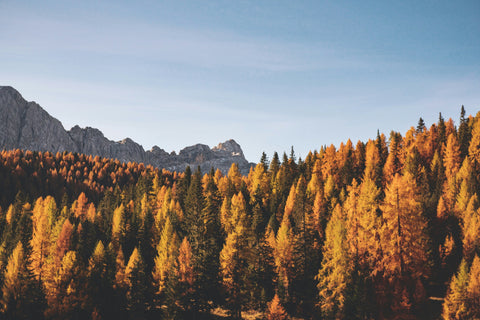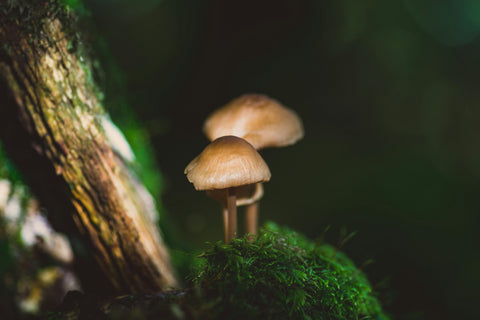There’s something about hiking in the fall that feels like stepping into a secret world.
The air turns crisp, the light turns golden, and every step sounds like a small celebration under your boots. The forest exhales, and so do you.
Now imagine resting beneath the maples, pulling out your PlantChoir, and hearing the trees sing. The soft hums and shifting tones are part of the forest’s own rhythm, layered over the wind, birds, and the hush of falling leaves.
It is not about adding sound. It is about listening deeper. If you are after simple fall hiking benefits, think cleaner air, calmer focus, and a soundtrack you can actually listen to.
Fall hiking benefits you feel right away
Cooler days make the miles feel friendlier. Your breath lands softly and your body does not have to fight the heat. Air often feels easier to breathe because ozone drops with cooler temperatures and many allergens back off as the season turns. That is not just a feeling. According to CircleDNA’s seasonal guide, outdoor time in autumn often means fewer irritants and gentler air, and according to GetUhoo’s AQI explainer, cooler conditions can ease pollutant build up.
Crowds thin. Quiet returns. You start to notice small things again. A woodpecker tapping somewhere beyond the bend. The creek telling stories to itself. Leaves speaking in paper voices. The quiet does not ask you to do anything. It gives you room to notice.
And the light. The sun rides lower and paints the world with honey and spice. You do not have to force mindfulness out here. The trail does most of the work.
One more quiet gift of the season. Fewer bugs. Fewer crowds. More room to listen.
A soft science lesson you can feel with your feet
Autumn looks slow, but the forest is busy. Leaves let go. Roots and microbes keep breathing. Carbon moves like a long tide. According to Dr. David Baldocchi’s review of global flux measurements, respiration from soils and roots often rises in fall and can briefly outpace photosynthesis when conditions are warm and moist. According to Dr. Koen Hufkens and colleagues, the timing of leaf drop strongly shapes seasonal carbon balance and the way many species keep time with climate.
Timing shapes everything else too. Birds migrate. Insects tuck in. Mushrooms rise after rain. According to Thackeray and coauthors, many species are sensitive to small temperature shifts, which means warm autumns can nudge schedules and sometimes cause mismatches. You can feel this if you pay attention. A flock that usually passes in early October shows up a week later. The berries they wanted are already gone.
According to Inside Climate News, the back and forth between extended photosynthesis and rising soil respiration is part of a larger autumn pivot that matters for climate. You do not need to memorize the details. You can feel the story in the air and the ground under your boots. The forest is tuning itself for winter. When you listen with PlantChoir, the tones can feel like that tuning made audible. A quiet pulse. A rise and settle. A living metronome for the rest of your day.
According to the University of Michigan Biological Station, fresh leaf litter feeds fungi and microbes and changes the understory as sunlight reaches plants that were shaded in summer. If you set the soil probes during your break, you might hear steadier, grounded tones. The forest floor holds a calm center while the canopy rustles.
Invasives, pests, and shifting characters on the trail
According to NC State University’s College of Natural Resources, longer warm periods can give invasive plants and insect pests an edge in autumn by extending growth or allowing extra life cycles. That extra pressure can stress native trees. On the ground this can look like thickets at the edge of a path that were not there a few seasons ago, or leaves that hold on longer where invaders are thriving. It is one more reason to notice who is growing where and to celebrate the pockets where native understory still glows.
Forest health and the slow change of who grows where
According to National Geographic’s reporting on fall foliage and climate trends, delayed leaf drop and chronic heat can nudge forests toward different mixes of species, sometimes favoring drought tolerant shrubs over sensitive trees. The change is slow at the scale of one hike. Across seasons you can feel it in which plants begin to fill the edges of the path and which trees stand a little thinner on the ridge.
Folding PlantChoir into a fall hike
Think of this as a small ritual. A pause with your senses open.
-
Find a friendly spot. A maple that scatters light. A fern near a mossy log. A pine that smells like resin and time.
-
Sit for a minute and let your ears wake up first.
-
If you are taking a longer pause, press your soil probes into the ground beside you. Sip something warm while the forest floor hums.
-
If the wind is playful, use the wet gel electrodes to your contact point. That tiny sticky thing helps the connection stay steady when leaves flicker.
-
If you are among evergreens, clip gently to a pine branch and listen to the airy tones that seem to float in the needles.
Choose soft instruments that sit in the background. Bells that breathe. Pads that drift. Keep the volume low so the forest can still talk.
If you like souvenirs that weigh nothing, record a minute or two and name it by place and date. Maple Overlook, October 18. Creek Bend, Late Afternoon. Over time you end up with a small album that smells like cedar every time you press play.
Mind and mood, one footstep at a time
Nature has a way of settling the mind without a lot of ceremony. Walking under trees. Hearing water. Touching bark. It all nudges your attention toward what is present and real. According to Medical West Hospital’s overview on autumn walks, time outdoors is linked with steadier mood, lower stress, and better sleep for many people. Pair that with color therapy from the woods and your thoughts begin to loosen. Good ideas arrive when you stop chasing them and start listening.
You may notice that the tones you hear during a PlantChoir pause become part of that soft focus. The music does not crowd your thoughts. It catches them gently and sets them down. Often you will leave a listening spot feeling like you have taken a deep breath that reached all the way into your toes.
A moment to tuck in your pocket
You step into a small clearing that feels like a secret. A fern still holding last night’s dew nods in the soft air. You kneel, place your clips, and wait. The first tones arrive like a whisper. Then they settle into a pattern that feels like a heartbeat written in light.
A chickadee calls. A leaf lands on your sleeve. You breathe in and out and find yourself smiling for no reason at all.
You sit a little longer than you planned. Then you stand and keep walking, carrying that quiet the rest of the way home.
Pack PlantChoir for your next autumn wander.
Use the soil probes while you rest, a touch of wet gel if the wind is lively, or a gentle clip to a pine branch. Breathe. Listen. Let the forest write you a song.
Setup Tutorial: Clips, Soil Probes, and Wet Gels
Use Cases at Home, Yoga, and Events
References
Baldocchi, D. (2010). Breathing of the terrestrial biosphere: Lessons from a global network of eddy covariance flux measurements.
CircleDNA Magazine. (2022). The benefits of outdoor activities in autumn.
GetUhoo. (2021). How seasonal changes affect air quality index.
Hufkens, K., Friedl, M., et al. (2023). Autumn, the neglected season in climate change research.
Inside Climate News. (2020). Forests, carbon, and autumn: Why the season matters for climate balance.
National Geographic. (2016). Off-season dangers in national parks you need to know.
National Geographic. (2022). Fall foliage disrupted by climate change might be the new normal.
NC State University, College of Natural Resources. (2021). Five climate change impacts on forests.
Thackeray, S. J., et al. (2016). Phenological sensitivity to climate across taxa.
University of Michigan Biological Station. (2023). Fall colors peak as researchers study seasonal transitions.





